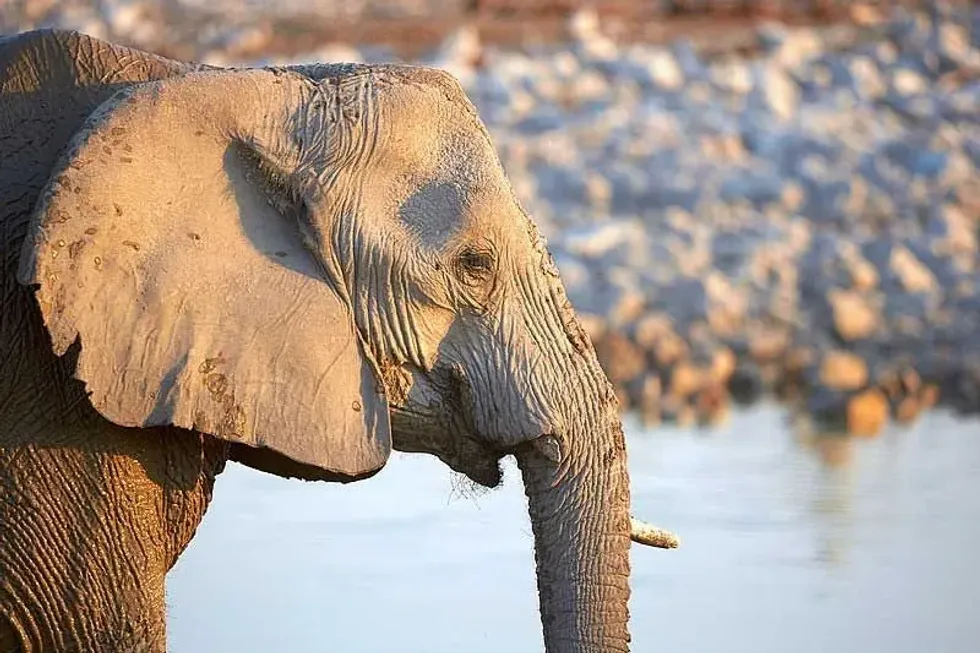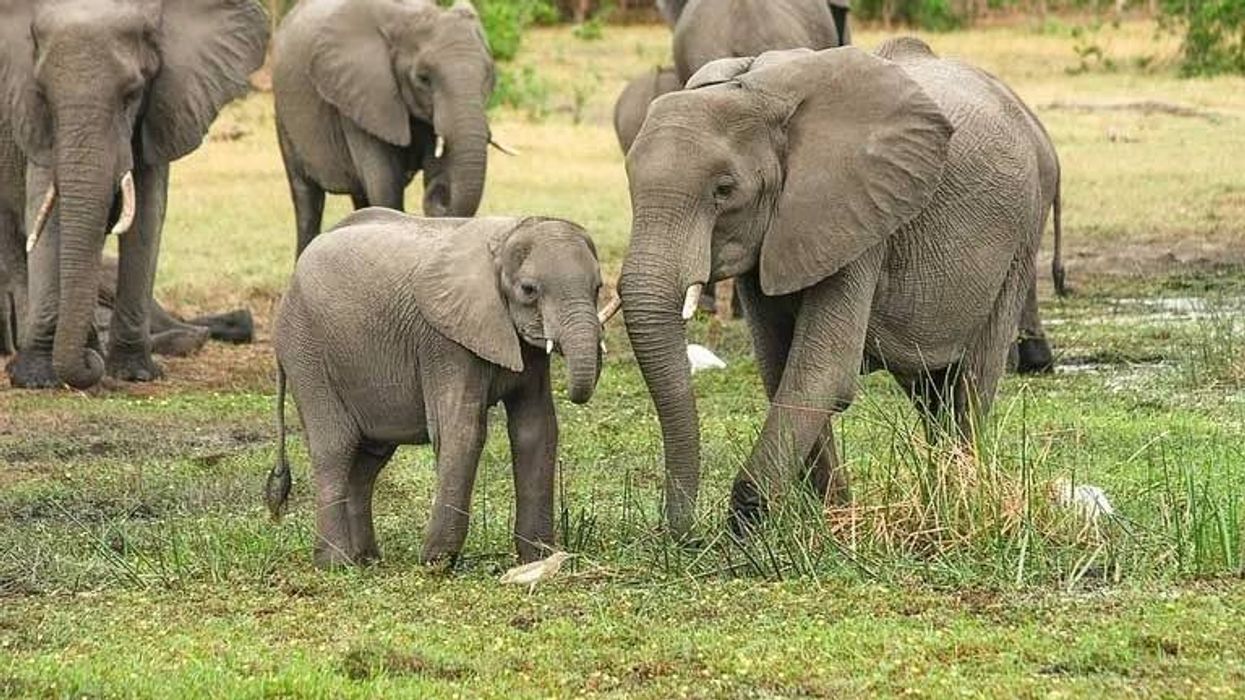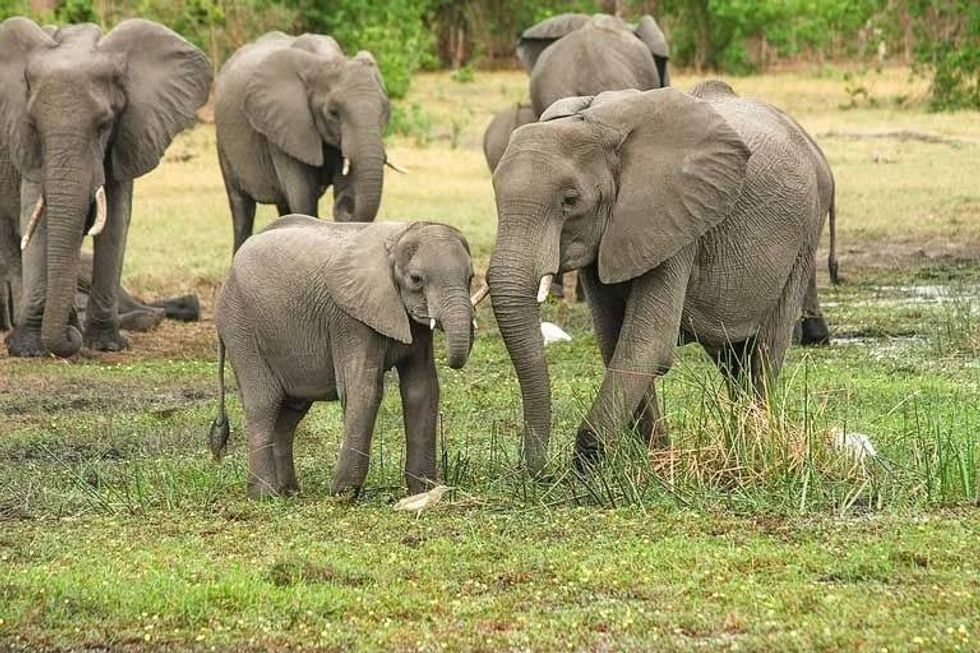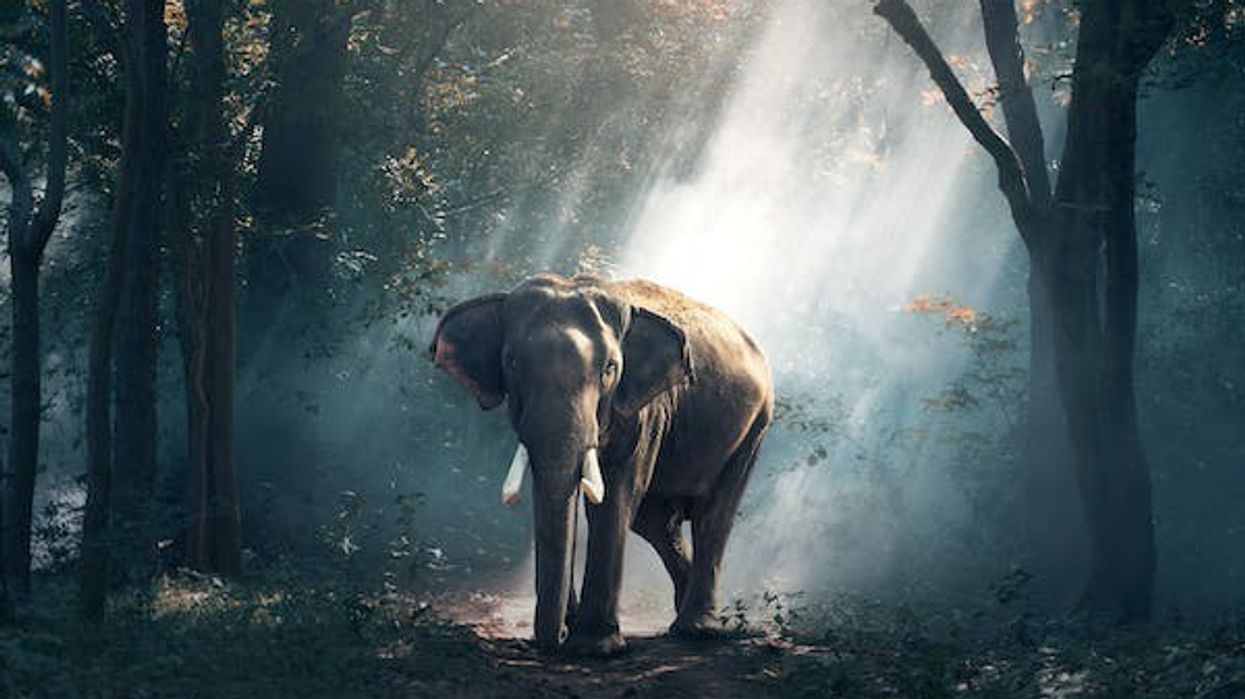Fun African Elephant Facts For Kids

Content
- What type of animal is an African elephant?
- What class of animal does an African elephant belong to?
- How many African elephants are there in the world?
- Where does an African elephant live?
- What is an African elephant's habitat?
- Who do African elephants live with?
- How long does an African elephant live?
- How do they reproduce?
- What is their conservation status?
- What do African elephants look like?
- How cute are they?
- How do they communicate?
- How big is an African elephant?
- How fast can an African elephant run?
- How much does an African elephant weigh?
- What are the male and female names of the species?
- What would you call a baby African elephant?
- What do they eat?
- Are they dangerous?
- Would they make a good pet?
- Did you know...
- What is the African name for the elephant?
- How many African elephants are killed every day?
The largest mammal on Earth is the African elephant, which makes them very special. These animals are found in 37 countries in Africa and live in a tropical climate.
Being native to Africa, they are found in many African forests. They have large tusks, which are their grown incisors. Elephant tusks grow throughout an elephant's life.
They have 26 teeth in total, including their tusks. They evolved large ears helping them stay cool as they don't have sweat glands and a long trunk that helps them in communicating and holding objects with ease.
African elephants have two subspecies – the savanna elephants, also known as bush elephants, and forest elephants. The former is bigger as compared to the latter: forest elephant. African elephants are known for the two finger-like endings on the end of their trunk.
The African elephants fall prey to human poaching, which is done for their ivory tusks. Along with the ivory trade, their skin and meat also have illegal markets.
Along with this, the habitat loss of these elephants has resulted in a decrease in their population. The forest elephants and savanna elephants are both poached, and hence, their conservation status has been moved to Endangered.
If you enjoy reading about this amazing mammal, you should definitely check out our other articles on the Sumatran elephant or the Borneo elephant.
African Elephant Interesting Facts
What type of animal is an African elephant?
The African elephant (Loxodonta africana) is an elephant. It is the largest animal on land, being a little larger than the Asian elephants.
What class of animal does an African elephant belong to?
An African elephant (Loxodonta africana) belongs to the class of mammals.
How many African elephants are there in the world?
In the wild, the elephant populations are counted to be 415,000. The elephant population has been dwindling since the beginning of the 20th century.
Where does an African elephant live?
African elephants are known to live in sub-Saharan Africa, West Africa, and central Africa. They are also found in the Sahel Desert in Mali. The climatic conditions where the elephant population likes to live are hot and arid. They are found in 37 countries in the continent of Africa.
What is an African elephant's habitat?
These large mammals have their habitats in deserts, savannas, forests, and marshes close to the sub-Saharan African rivers. Their habitat is open and wild, where they can roam freely and live an independent life.
The African elephants, savanna elephants and forest elephants, like to live in arid and hot regions and love to feed on roots, fruits, plants, and grass. They also have an important ecological role as they help in maintaining waterholes for smaller mammals.
These elephants don't just survive in their habitat, but they also help maintain a proper and suitable habitat for other animal species.
Who do African elephants live with?
The male elephants are known to be loners as they prefer to live a solitary life. Sometimes, they are found in smaller groups with other males.
Elephants in the savannah are known to live in groups called herds. These groups have up to 10 members, and sometimes, they join other groups and make a clan. These clans have around 70 members, and a female elephant leads them.
Elephants walk in a line led by the matriarch as they move from one place to another and they each hold the tail in front of them with their trunks. This is because the matriarch loves to lead a unified front for protection and also explains why they live in herds.
How long does an African elephant live?
An African elephant's lifespan is between 50-70 years in the wild where they could die naturally due to starvation, old age, or predators, and is 17 years in captivity.
How do they reproduce?
When bull elephants mature, they go through musth - a periodic transformation where the testosterone levels of males reach 10 times higher than normal levels. This transformation can be seen by few characteristics in elephants like enlarged temporal glands, aggressive behavior, and continuous urine dribble while walking.
Males flaunt their bodies in front of females for mating purposes and often fight each other due to aggressive behaviors and mating competition. These fights can lead to death as well.
During the breeding season of this largest land mammal, the female conceives and has a gestation period of 22 months. This gestation period is the longest among all mammal species.
After the gestation period is over, one calf is born. After an hour of birth in the wild, the young one is ready to stand up easily and walk. It stays with its mother and entire herd till it becomes an adult.
The herd is known to form a protective circle around young ones if a danger is detected nearby. Male elephants, on the other hand, have no contribution in taking care of these calves.
The baby elephant grows tusks after its milk teeth fall off at around six to 12 months. The tusks then continue to grow at seven in (17 cm) every year.
The baby elephant feeds on the mother's milk for five to six years, and it takes 13-20 years for them to mature. By the time they are mature, they learn social nuances, coordination, and know-how to develop bonds.
If a calf is not properly reared, it can be anti-social when mature. When these babies grow up, males leave the herd, whereas females stay with the herd.
What is their conservation status?
The conservation status of these African elephants is Endangered. This is because of the habitat loss due to development in the forested areas.
Along with this, the reasons that the elephant populations are dwindling are poaching and hunting of these animals. The international agreement ensured that the ivory trade was banned in the year 1989.
This ivory trade ban resulted in a decrease in the poaching of these animals. After this, China banned the trade in its domestic market in 2018, which has greatly helped elephant populations.
As regulations have been imposed, it will still take a while for elephant populations to come back to a good count because of their low birth rates. Elephants live up to a good age, but calves are in danger with predators trying to feed on them.
Hyenas, leopards, lions, African wild dogs, and tigers can easily ill the calves. They can be protected if they are in protected areas of the herd where adults can protect them.
African Elephant Fun Facts
What do African elephants look like?
Elephants are the largest mammal species present on Earth. They have really big bodies, a strong trunk, large ears, thin tails, stout legs, and ivory tusks. The ivory tusks are nothing other than the incisor teeth that grow throughout their life.
These ivory tusks help them in defending themselves, digging, and lifting heavy objects. Elephants also have really thick gray wrinkled skin. The skin is thick to protect them from their predators.
Animals with thick outer skin are called pachyderms. The tail can be 4 ft (1.2 m) long. The outer skin of an elephant is called the epidermis.
The elephant's upper lip and nose fuse together to form the elephant's trunk. It is one of the most useful parts of the elephant's body. It is used in smelling, communicating, and showing affection or grief by touching other elephants. The tip of the trunk of the elephants has finger-like ends that help them in grasping objects.
The elephant's ears are large and round, about 6 ft (1.8 m) in length. They are important as they help elephants in staying cool.
The large size of the ears has various blood vessels, which helps in the blood flow within capillaries, helping them release the heat from their body. Elephants flap their ears, which is the best indication that they are releasing heat.

How cute are they?
These animals are cute when they are young. Even when they are grown, they look cute enough, but their cuteness should not fool you. They are huge and can bring destruction if they are in a bad mood.
How do they communicate?
Elephants – whether it be Asian elephants or African elephants – have various ways in which they communicate. Their communication skills consist of both vocalizations and body language.
Elephants make sounds to communicate with other members. The vocalizations used by this wildlife creature are snorts, rumbles, roars, barks, and cries. Their sounds are sometimes low and sometimes of high frequency. The African elephant, as opposed to the Asian elephant, makes low rumbling sounds.
These sounds travel long distances. These sounds are a result of vocal cords, which can be lengthened or shortened depending on the tone that elephants use. This can also help in changing the frequency of sounds that elephants use.
Other than sounds, elephants are also known to use feet vibrations for communicating. Their feet have soft nerves, and they can easily pick up frequencies from other members. Right from their toenails to their ears, the vibration is felt, and the sound is detected.
Other than feet and sounds, movements are another form of communication for elephants. These movements include stepping back or ear folding. The spreading of their ears means that elephants are scaring other elephants, which is also a sign of aggression. When elephants feel playful, they will simply bob their heads and might climb on other members.
Elephants use all these communication styles to stay in contact with each other. These communication methods also help elephants protect themselves against the danger that these species face in the wild.
Living in the wild isn't easy, and constant communication is important for these mammals from Africa to protect themselves from being poached for the ivory trade and other human benefits.
How big is an African elephant?
An African elephant has a length ranging between 8.2-13 ft (2.5-4 m). Males are larger than females. African elephants are slightly bigger than their cousins - Asian elephants, making them the largest land mammal.
How fast can an African elephant run?
The elephant from South Africa is known to run at a speed of 25 mph (40 kph).
How much does an African elephant weigh?
The weight of these elephants from South Africa ranges between 5000-14000 lb (2268-6350 kg).
What are the male and female names of the species?
The male and female African elephants have distinct names. The male African elephants are known as bull elephants, whereas the female African elephants are known as cow elephants.
What would you call a baby African elephant?
The African baby elephant is known as a calf. The calves can weigh up to 200 lb (91 kg) and have a length of up to 3 ft (0.9 m). The young ones can recognize the touch, sound, and scent of their mothers when they are born. Elephants do not stop growing until they reach the age of 20-25.
What do they eat?
Being herbivores, these mammals are known to feed on leaves, grass, roots, barks, and fruits. These are easily available in the wildlife, and hence, these animals live more freely in wildlife habitats. An Indian elephant eats grass, tree bark, leaves, roots, stems, and leaves.
Are they dangerous?
From a distance, these wildlife mammals do not look as dangerous, but they are. As the largest mammal on land, these wildlife creatures must be respected and feared.
Even though elephants live in protected areas like a national park or the wild, they are known to kill 500 human beings in a year. The human-elephant conflict can only be dangerous for humans.
Humans are their biggest predators, and their greed has led to the poaching of these innocent creatures for their ivory tusks. These ivory tusks are their pride, and if these tusks are removed, it can lead to poor life quality for elephants as they can't survive without them.
However, if the tusk is trimmed, it can regrow. These tusks don't fall off on their own.
Would they make a good pet?
These wildlife creatures must not be kept as pets. These mammals are made for the wildlife, and it will not be fair to keep them as pets.
Although, these mammals are kept in a national park or more protected areas to provide better conservation and protect them from poaching. As elephant population conservation is a concern, it is also illegal to trade elephants for money.
Captivated elephants can only be transferred from one owner to another. Around 15,000-20,000 elephants are estimated to be held captive worldwide. They can even be trained for educational or entertainment purposes.
As of 2006, 147 African elephants and 139 Asian elephants were kept captive in American zoos. They are made to work in a circus, zoo, camp, or sanctuary.
Did you know...
Elephants are really smart and form bonds with other members. They hug and console each other when stressed. They can also show grief. They can also recognize themselves if they look in the mirror.
Mud baths are beneficial for these mammals as it protects them from the heat of the sun and cleans their skin.
These elephants have a sharp memory and can remember details for a very long time.
Their head can weigh over 881 lb (400 kg).
Learned behavioral traits include mothering skills, reproductive skills, learning what and how to eat, vocal learning, and how to use tools.
What is the African name for the elephant?
Elephants are called Olifant in Afrikaans. African elephants have two species – the African bush elephant and the African forest elephant. The African bush elephant's scientific name is Loxodonta africana. They are also called the savanna elephant. The African forest elephant's scientific name is Loxodonta cyclotis. African elephants also have a closely related member – the Asian elephant.
How many African elephants are killed every day?
On average, almost 100 African elephants are killed every day. This wildlife creature is killed for its meat, ivory trade, and its body parts.
The poaching in Africa has resulted in a decline in the number of these wildlife mammals. The poaching of this wildlife animal needs to be stopped because these mammals are an important part of the ecosystem. These mammals help in controlling the vegetation growth in the wild.
They are also responsible for creating waterholes that other animals use. They find water by digging into the ground with their trunks, feet, and tusks.
These species have tusks that are removed during poaching. Tusks have living tissue and nerves, and hence, it is painful for them when they are removed. Tusks do not fall off on their own and, if removed, it results in a reduced quality of life for these mammals.
Here at Kidadl, we have carefully created lots of interesting family-friendly animal facts for everyone to discover! Learn more about some other mammals from our Spanish mastiff facts and ghost bat facts pages.
You can even occupy yourself at home by coloring in one of our free printable African elephant coloring pages.
We Want Your Photos!
More for You
See All
Bachelor of Commerce specializing in Accounting and Finance, Master of Business Administration

Divya RaghavBachelor of Commerce specializing in Accounting and Finance, Master of Business Administration
With a diverse range of experience in finance, administration, and operations, Divya is a diligent worker known for her attention to detail. Born and raised in Bangalore, she completed her Bachelor's in Commerce from Christ University and is now pursuing an MBA at Narsee Monjee Institute of Management Studies, Bangalore. Along with her professional pursuits, Divya has a passion for baking, dancing, and writing content. She is also an avid animal lover who dedicates her time to volunteering for animal welfare causes.
Bachelor of Commerce specializing in Marketing and HR

Pradhanya RaoBachelor of Commerce specializing in Marketing and HR
With a Bachelor’s degree in Commerce from Christ University, Bangalore, Pradhanya's passion for the English language and literature led her to explore the field of content writing, where she has gained extensive experience in writing, reviewing, editing, and fact-checking. She has also earned certifications in Google Ads Search, Google Ads Display, and Social Media Marketing, showcasing her proficiency in digital marketing.
Disclaimer
1) Kidadl is independent and to make our service free to you the reader we are supported by advertising. We hope you love our recommendations for products and services! What we suggest is selected independently by the Kidadl team. If you purchase using the Buy Now button we may earn a small commission. This does not influence our choices. Prices are correct and items are available at the time the article was published but we cannot guarantee that on the time of reading. Please note that Kidadl is a participant in the Amazon Services LLC Associates Program, an affiliate advertising program designed to provide a means for sites to earn advertising fees by advertising and linking to Amazon. We also link to other websites, but are not responsible for their content.
2) At Kidadl, we strive to recommend the very best activities and events. We will always aim to give you accurate information at the date of publication - however, information does change, so it’s important you do your own research, double-check and make the decision that is right for your family. We recognise that not all activities and ideas are appropriate for all children and families or in all circumstances. Our recommended activities are based on age but these are a guide. We recommend that these ideas are used as inspiration, that ideas are undertaken with appropriate adult supervision, and that each adult uses their own discretion and knowledge of their children to consider the safety and suitability. Kidadl cannot accept liability for the execution of these ideas, and parental supervision is advised at all times, as safety is paramount. Anyone using the information provided by Kidadl does so at their own risk and we can not accept liability if things go wrong.
3) Because we are an educational resource, we have quotes and facts about a range of historical and modern figures. We do not endorse the actions of or rhetoric of all the people included in these collections, but we think they are important for growing minds to learn about under the guidance of parents or guardians.







